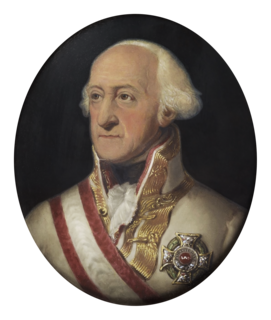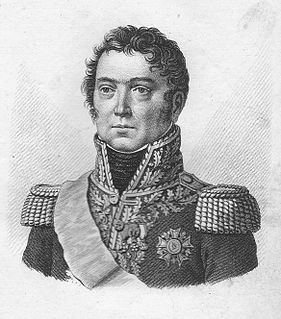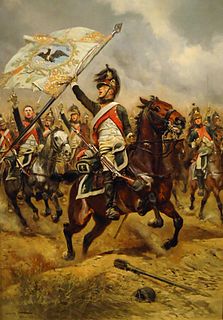This is the complete order of battle of the French and Third Coalition armies during the Battle of Austerlitz.

The Battle of Montebello was fought on 9 June 1800 near Montebello in Lombardy. During the lead-up to the Battle of Marengo, the vanguard of the French army in Italy engaged and defeated an Austrian force in a "glorious victory".
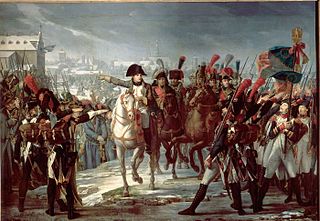
The II Corps of the Grande Armée was a military unit that existed during the Napoleonic Wars.
The Army of the Moselle was a French Revolutionary Army from 1791 through 1795. It was first known as the Army of the Centre and it fought at Valmy. In October 1792 it was renamed and subsequently fought at Trier, First Arlon, Biesingen, Kaiserslautern, Froeschwiller and Second Wissembourg. In the spring of 1794 the left wing was detached and fought at Second Arlon, Lambusart and Fleurus before being absorbed by the Army of Sambre-et-Meuse. In late 1794, the army captured Trier and initiated the Siege of Luxembourg. During the siege, the army was discontinued and its divisions were assigned to other armies.
In the Battle of Rivoli on 14 and 15 January 1797, the French Army of Italy led by Napoleon Bonaparte crushed the main Austrian army led by Jozsef Alvinczi. The battle occurred during the fourth Austrian attempt to relieve the Siege of Mantua. After crippling Alvinczi's army on the 14th, Bonaparte left Barthélemy Joubert and Gabriel Rey to finish off the Austrians and raced south with André Masséna to deal with a relief column led by Giovanni di Provera. On 16 January, Masséna, Pierre Augereau, and Jean Sérurier trapped Provera near the Mantua siege lines and forced his surrender.

On 25 March 1799, French and Austrian armies fought for control of the geographically strategic Hegau in present-day Baden-Württemberg. The battle has been called by various names: First Battle of Stockach, the Battle by Stockach, and, in French chronicles, the Battle of Liptingen.

In the Battle of Hohenlinden on 3 December 1800, a French army commanded by Jean Victor Marie Moreau decisively defeated the army of Habsburg Austria led by Archduke John. The first action of the campaign was the Battle of Ampfing, two days earlier. After Hohenlinden there was a series of rearguard clashes beginning on 9 December at Rosenheim and continuing from the 14th through the 20th at Salzburg, Neumarkt am Wallersee, Frankenmarkt, Schwanenstadt, Vöcklabruck, Lambach, and Kremsmünster. During the retreat, the Austrian army began a process of disintegration and an armistice was concluded a few days later.
In the Battle of Sankt Michael on 25 May 1809, Paul Grenier's French corps crushed Franz Jellacic's Austrian division at Sankt Michael in Obersteiermark, Austria. The action occurred after the initial French victories during the War of the Fifth Coalition, part of the Napoleonic Wars. Sankt Michael is located approximately 140 kilometers southwest of Vienna.

Caldiero 1805 Order of Battle

The Battle of Verona was fought on 18 October 1805 between the French Army of Italy under the command of André Masséna and an Austrian army led by Archduke Charles, Duke of Teschen. By the end of the day, Massena seized a bridgehead on the east bank of the Adige River, driving back the defending troops under Josef Philipp Vukassovich. The action took place near the city of Verona in northern Italy during the War of the Third Coalition, part of the Napoleonic Wars.

The Battle of Abensberg was fought on 20 April 1809, between an Allied force under the command of Emperor Napoleon I of France on one side and three Austrian corps led by Johann von Hiller, Archduke Louis of Austria, and Michael von Kienmayer. The Austrians formed the left wing of Archduke Charles, Duke of Teschen's main army and were under the overall command of Hiller. Napoleon's French troops, reinforced by troops from the Kingdom of Bavaria and the Kingdom of Württemberg outfought their opponents, inflicted heavy losses, and forced the Austrians to retreat to the southeast.

The Battle of Neumarkt-Sankt Veit on 24 April 1809 saw a Franco-Bavarian force led by Marshal Jean-Baptiste Bessières face an Austrian Empire army commanded by Johann von Hiller. Hiller's numerically superior force won a victory over the Allied troops, forcing Bessières to retreat to the west. Neumarkt-Sankt Veit is located ten kilometers north of Mühldorf and 33 kilometers southeast of Landshut in Bavaria.
The Battle of Sacile saw the Franco-Italian Army of Italy commanded by Eugène de Beauharnais face the Archduke John of Austria's Army of Inner Austria during the War of the Fifth Coalition. Believing that he was only opposed by the Austrian VIII Armeekorps, Eugène launched his right wing in a heavy attack against it. In the morning, the Austrians successfully held off Franco-Italian assaults on their left flank as Eugène reinforced the attack with troops from his left wing. Later in the day, John counterattacked Eugène's weakened left wing with the IX Armeekorps, forcing the Franco-Italian army to withdraw from the battlefield. The battle at Sacile was preceded by the action of Pordenone on 15 April in which the Austrian advance guard mauled the French rear guard. The Austrian victory compelled Eugène to retreat to the Adige River at Verona where he gathered reinforcements and planned a counteroffensive.
The Hanau order of battle shows the forces engaged at the 1813 battle of Hanau, during the War of the Sixth Coalition, when a French force under Emperor of the French Napoleon I defeated a vastly superior Austro-Bavarian force commanded by General Karl Philipp von Wrede.
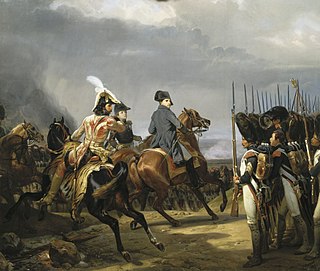
The Jena-Auerstedt Campaign Order of Battle is listed below. The order of battle includes units from the First French Empire and the Kingdom of Prussia that fought each other in the campaign that included the decisive Battle of Jena-Auerstedt on 14 October 1806. The order of battle may be useful to trace the battles of Schleiz and Saalfeld, which occurred before Jena-Auerstedt, as well as battles and capitulations that happened after 14 October, such as Erfurt, Halle, Prenzlau, Pasewalk, Stettin, Waren-Nossentin, and Lübeck.
The XI Corps of the Grande Armée was the name of a French military unit that existed during the Napoleonic Wars. In 1809 during the War of the Fifth Coalition, General of Division Auguste Marmont's Army of Dalmatia was renamed the XI Corps. Emperor Napoleon I held it in reserve at the Battle of Wagram. In 1812, the unit was reconstituted during the invasion of Russia and placed under Marshal Pierre Augereau. It did not fight in any battles and instead served a collection point for reserves. In spring 1813, it was reorganized and placed under the command of Marshal Jacques MacDonald. The corps fought at Lutzen, Bautzen, the Katzbach, Leipzig, and Hanau in 1813. Still under MacDonald, the unit fought at Bar-sur-Aube and several minor actions in 1814.
The Piave River 1809 Order of Battle shows the units and organization for the Franco-Italian and Austrian Empire armies that fought in the Battle of Piave River on 8 May 1809. Eugène de Beauharnais, the viceroy of the Kingdom of Italy defeated Archduke John of Austria. Eugène's Advance Guard crossed the river first and was assailed by Austrian cavalry and artillery. The French cavalry routed the opposing cavalry and captured 14 enemy guns. A lull followed as John arranged his infantry in a formidable defensive position. Meanwhile, Eugène struggled to pour reinforcements into the bridgehead as the Piave rose dangerously. In the afternoon, the viceroy sent Paul Grenier to drive back the Austrian left while Jacques MacDonald mounted an assault on the center. The attack succeeded in breaking the Austrian line and compelling John to order a retreat.
II Cavalry Corps was a French military formation during the Napoleonic Wars. It was first formed in December 1806, but only enjoyed a brief existence under Marshal Jean-Baptiste Bessières. The II Cavalry Corps was reconstituted for the French invasion of Russia in 1812 and commanded by General of Division Louis-Pierre Montbrun who was killed in battle, as was his successor a few hours later. In the War of the Sixth Coalition, General of Division Horace François Bastien Sébastiani de La Porta led the corps in 1813. General of Division Antoine-Louis Decrest de Saint-Germain directed the corps in 1814. During the Hundred Days, Napoleon raised the corps again and entrusted it to General of Division Rémi Joseph Isidore Exelmans.
The VII Corps of the Grande Armée was the name of a French military unit that existed during the Napoleonic Wars. It was formed in 1805 and assigned to Marshal Pierre Augereau. From 1805 through 1807, Augereau led the army corps in the War of the Third Coalition and the War of the Fourth Coalition. It was disbanded after being nearly wiped out at the Battle of Eylau in February 1807 and its surviving troops were distributed to other army corps. At the end of 1808, the VII Corps was reconstituted in Catalonia during the Peninsular War and Laurent Gouvion Saint-Cyr was given command. The corps fought in Spain until 1811, when it was renamed the Army of Catalonia. At that time it was again led by Augereau.

The Battle of Messkirch on 5 May 1800 was the second major engagement of the Rhine Campaign of 1800. It followed the Battle of Stockach on 3 May. The campaign began on 25 April when a French force emerged from the Kehl bridgehead. This marked the start of the offensive of Jean Victor Marie Moreau's Army of the Rhine against Paul Kray's army of Habsburg Austria and its Bavarian, Württemberg and other German allies.


